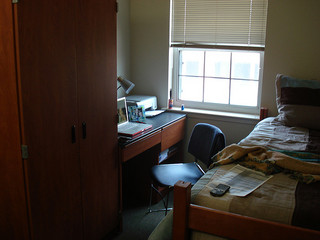Residential Re-Education: Not Everything Is About Race

Why, then, do our programs through the Office of Residential Education insist on dividing us by race?
Living in a dorm is a quintessential part of almost every college student’s life. At USC, this means that almost every student will come into contact with the Office of Residential Education – ResEd – during the very first part of their college career. I lived in a dorm through USC Housing during my freshman year that was home to several different “special interest” floors. The point of these floors is to provide students with living companions with whom they share some sort of common ground. In other residence halls, this meant options like “The Cinema Floor” (for residents interested in film) and “The Great Outdoor Floor” (for residents interested in outdoor activities).
The dorm I lived in, however, had floors for black and Hispanic students (respectively titled “Somerville” and “El Sol y La Luna,” colloquially called “the black floor” and “the Latino floor”).
As someone whose race cannot be easily determined simply by looking at the color of my skin, I was frequently (most memorably on my very first day of freshman year) assumed to be a resident of “the black floor” or “the Latino floor” by RAs and other employees of the Office of Residential Education. It made me uncomfortable and insecure about my race for the first time in my entire life, and it made me wonder: at this point in time, is it really necessary to have floors devoted to race? Isn’t this the type of de jure segregation that Brown v. Board of Education tried to stop by integrating schools over sixty years ago? And, perhaps most importantly, at a place of higher education, aren’t there things other than race that we can use to define ourselves?
I left the uncomfortable racial confines of my freshman dorm as soon as I could, with the intention of never going back to a residence hall. But, because I have friends still living in USC Housing, I do wind up there on occasion. Recently, I was visiting someone in a residence hall who happens to be a residential advisor (RA). The RA revealed to me that she and the rest of her staff were being required to change their bulletin boards this weekend to reflect a celebration of Black History Month. Black History Month takes place in the month of February, and is seen by many as an opportunity to celebrate the many achievements of blacks in American and global society. My question, though, was why Residential Education felt the need to ensure a public celebration of Black History Month while all other months devoted to celebrating a particular ethnic group have gotten ignored.
According to the most recent statistics available, the population of students at USC is approximately 39 percent white, 23 percent Asian, 14 percent Hispanic, 12 percent International, seven percent “other” and five percent black/African-American. And, according to the 2000 “Mapping LA” project of the Los Angeles Times, the ethnic breakdown of South Los Angeles (USC’s surrounding neighborhood) is 56.7percent Latino, 38 percent black, 2.2 percent white, 1.6 percent Asian and 1.5 percent “other”.
Clearly, there is a large Hispanic/Latino presence both at USC and in the surrounding area. You would think that Residential Education, an office that strives to be inclusive of all people, would see the 14 percent Hispanic population of USC and the almost 57 percent Hispanic population of the surrounding area as something worth mentioning on a bulletin board. But, National Hispanic Heritage Month (which took place from Sep. 15 to Oct. 15) went by without so much as a whisper, let alone an entire building of bulletin boards. Similarly, in all of my time in residence halls I’ve never seen a mention of Asian Pacific Heritage Month (which takes place every year in May) despite the fact that the population of USC is made up of almost one-quarter Asians.
Of all populations, in fact, black students make up the smallest demographic portion at USC. I am not saying that this is a reason to disregard Black History Month. But, if Residential Education as an organization is going to openly celebrate the history and accomplishments of one race, they shouldn’t disregard others in the process – particularly if those other races make up the majority of this university.
I understand the difficulties that Residential Education may face in attempting to be sensitive to everyone’s needs and desires. I understand that, in some ways, they are probably attempting to be politically correct in insisting that all of their employees celebrate Black History Month. But, if anyone working for ResEd had stopped to consider the greater implications of celebrating one race while ignoring all others, I think they would’ve come to my conclusion: not everything is about race. I’m not sure that a discussion of race has a place at all in a university’s residence halls – and, if USC’s ResEd is going to start that discussion, they should be prepared to finish it too.



